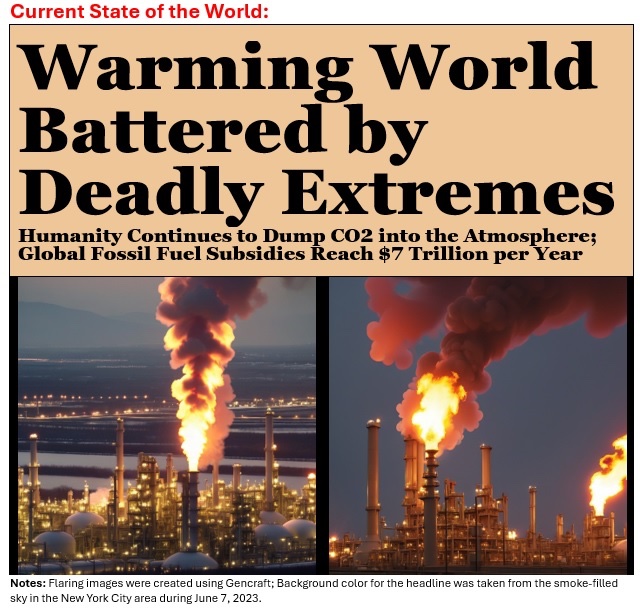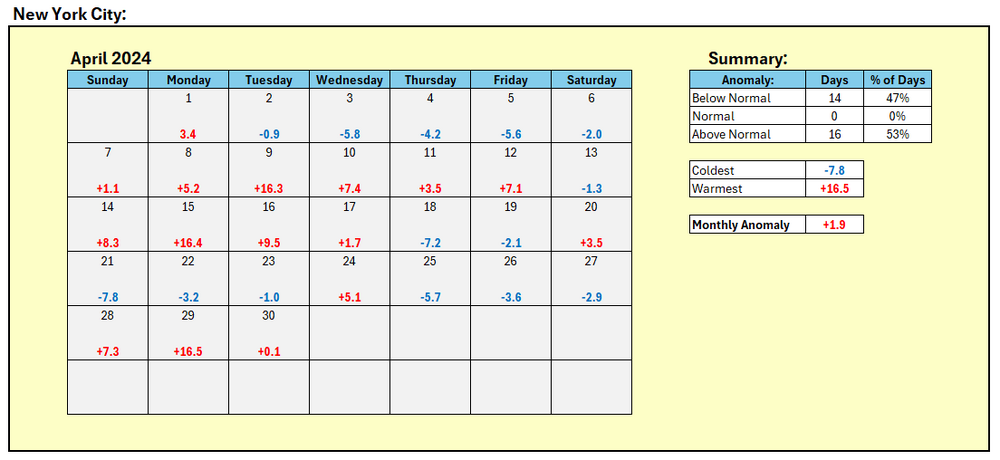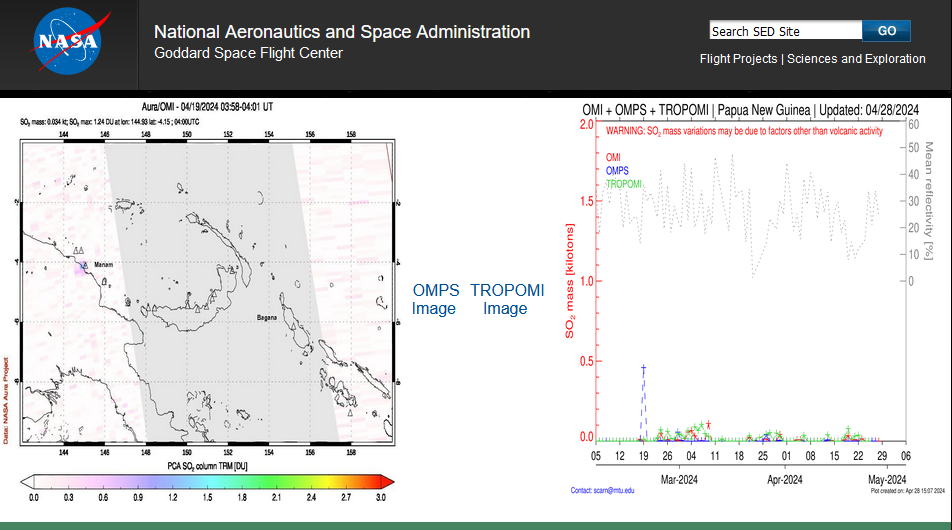-
Posts
22,986 -
Joined
Content Type
Profiles
Blogs
Forums
American Weather
Media Demo
Store
Gallery
Everything posted by donsutherland1
-

Occasional Thoughts on Climate Change
donsutherland1 replied to donsutherland1's topic in Climate Change
The persistent blockiness has precluded its advance. There are some hints that the blocking could finally break down for good in the very long range (late May or early June timeframe). -

Occasional Thoughts on Climate Change
donsutherland1 replied to donsutherland1's topic in Climate Change
La Puerta, TX also reached 116. -
Even as cooler air began pushing into the East, parts of Texas experienced record heat. In fact, McAllen reached 111°, which tied that city's all-time record high that had been set on June 22, 2017. Tomorrow will be mainly cloudy and cool with showers and some periods of light rain. The temperature will likely top out only in the middle and upper 50s across much of the region. A dry but still cool weekend will follow. The ENSO Region 1+2 anomaly was 0.8°C and the Region 3.4 anomaly was +0.5°C for the week centered around May 1. For the past six weeks, the ENSO Region 1+2 anomaly has averaged -0.08°C and the ENSO Region 3.4 anomaly has averaged +0.85°C. The ongoing basinwide El Niño event is fading. Neutral conditions could develop later in the spring. The SOI was -1.82 today. The preliminary Arctic Oscillation (AO) was -0.278 today. Based on sensitivity analysis applied to the latest guidance, there is an implied 60% probability that New York City will have a warmer than normal May (1991-2020 normal). May will likely finish with a mean temperature near 64.2° (1.0° above normal).
- 1,603 replies
-
- 1
-

-
- spring
- cool temps
-
(and 3 more)
Tagged with:
-
Another shot of cooler air will begin to arrive tomorrow. The chill won't be exceptional for the season. However, Friday could be mainly cloudy with highs only in the 50s in much of the region. Some showers are possible. The ENSO Region 1+2 anomaly was 0.8°C and the Region 3.4 anomaly was +0.5°C for the week centered around May 1. For the past six weeks, the ENSO Region 1+2 anomaly has averaged -0.08°C and the ENSO Region 3.4 anomaly has averaged +0.85°C. The ongoing basinwide El Niño event is fading. Neutral conditions could develop later in the spring. The SOI was +12.12 today. The preliminary Arctic Oscillation (AO) was -0.368 today. Based on sensitivity analysis applied to the latest guidance, there is an implied 57% probability that New York City will have a warmer than normal May (1991-2020 normal). May will likely finish with a mean temperature near 64.2° (1.0° above normal).
- 1,603 replies
-
- spring
- cool temps
-
(and 3 more)
Tagged with:
-
The mean temperature in New York City during the first week of May was 61.6°. That was 1.6° above normal. After a morning shower or thundershower, tomorrow will be another unseasonably warm day with readings reaching the upper 70s and lower 80s across the region. The highest readings are likely in and around Philadelphia where the temperature could top out in the middle or even upper 80s. Another shot of cooler air will likely arrive on Thursday. The chill won't be exceptional for the season. The ENSO Region 1+2 anomaly was 0.8°C and the Region 3.4 anomaly was +0.5°C for the week centered around May 1. For the past six weeks, the ENSO Region 1+2 anomaly has averaged -0.08°C and the ENSO Region 3.4 anomaly has averaged +0.85°C. The ongoing basinwide El Niño event is fading. Neutral conditions could develop later in the spring. The SOI was +7.14 today. The preliminary Arctic Oscillation (AO) was +0.200 today. Based on sensitivity analysis applied to the latest guidance, there is an implied 60% probability that New York City will have a warmer than normal May (1991-2020 normal). May will likely finish with a mean temperature near 64.3° (1.1° above normal).
- 1,603 replies
-
- spring
- cool temps
-
(and 3 more)
Tagged with:
-
Tomorrow and Wednesday will be unseasonably warm days with readings reaching the upper 70s and lower 80s across the region with the highest readings likely in and around Philadelphia. Overall, the first week of May will very likely wind up warmer than normal. Another shot of cooler air wil likely arrive on Thursday. The ENSO Region 1+2 anomaly was 0.8°C and the Region 3.4 anomaly was +0.5°C for the week centered around May 1. For the past six weeks, the ENSO Region 1+2 anomaly has averaged -0.08°C and the ENSO Region 3.4 anomaly has averaged +0.85°C. The ongoing basinwide El Niño event is fading. Neutral conditions could develop later in the spring. The SOI was +6.22 today. The preliminary Arctic Oscillation (AO) was -0.285 today.
- 1,603 replies
-
- spring
- cool temps
-
(and 3 more)
Tagged with:
-
Showers and periods of light rain are likely into tomorrow. Tomorrow and Tuesday will become noticeably warmer as the clouds yield to sunshine. Overall, the first week of May should wind up warmer than normal despite today's cool weather. Another shot of cooler air wil likely arrive on Thursday. The ENSO Region 1+2 anomaly was 0.0°C and the Region 3.4 anomaly was +0.8°C for the week centered around April 24. For the past six weeks, the ENSO Region 1+2 anomaly has averaged -0.23°C and the ENSO Region 3.4 anomaly has averaged +0.98°C. The ongoing basinwide El Niño event is fading. Neutral conditions could develop later in the spring. The SOI was +7.37 today. The preliminary Arctic Oscillation (AO) was -0.285 today.
- 1,603 replies
-
- 1
-

-
- spring
- cool temps
-
(and 3 more)
Tagged with:
-
He is stirring up a "Witches' Brew" of analogs for which the selection seems more astrological than scientific in nature. 1995-96 was a much weaker La Niña event than is currently forecast with a PDO+. 2010-11 featured extreme blocking. 2013-14 was a Neutral ENSO event. 2014-15 was an El Niño winter. It should be noted that every strong La Niña since 1950 featured a negative PDO. These discontinuities suggest that there is no objective framework behind the analog selection. Very likely, his desire to forecast a cold and snowy winter (possibly as an argument that winters aren't warming, an argument he lost long ago) is the guiding force driving his emerging winter idea. That his past two winter forecasts have been debacles does not seem to have discouraged him from trying again. Random chance may sometimes intervene, but the lack of an objective forecasting framework assures that he won't see consistent forecasting success.
-

Occasional Thoughts on Climate Change
donsutherland1 replied to donsutherland1's topic in Climate Change
It is now 1,000 days since the IPCC declared that it is “unequivocal” that human activities have warmed the climate. No country has even considered setting targets for beginning a phaseout of the fossil fuel burning responsible for climate change. Meanwhile, major floods swamp parts of Texas, Brazil, and China while exceptional heat bakes parts of Brazil and Southeast Asia. -
They both might turn positive for a period later next week, but sustained positive regimes may not occur until later in the month.
- 1,603 replies
-
- 1
-

-
- spring
- cool temps
-
(and 3 more)
Tagged with:
-
Showers and periods of rain are likely tomorrow into Monday. A general 0.25"-0.50" of rain is likely. It will be unseasonably cool with the high temperature reaching only the upper 50s in much of the New York City area and low 60s in southern New Jersey and Philadelphia. Monday and Tuesday will become noticeably warmer. Overall, the first week of May should wind up warmer than normal. The ENSO Region 1+2 anomaly was 0.0°C and the Region 3.4 anomaly was +0.8°C for the week centered around April 24. For the past six weeks, the ENSO Region 1+2 anomaly has averaged -0.23°C and the ENSO Region 3.4 anomaly has averaged +0.98°C. The ongoing basinwide El Niño event is fading. Neutral conditions could develop later in the spring. The SOI was +3.16 today. The preliminary Arctic Oscillation (AO) was -1.742 today.
- 1,603 replies
-
- 1
-

-
- spring
- cool temps
-
(and 3 more)
Tagged with:
-
Yes. We have an AO-/NAO-
- 1,603 replies
-
- spring
- cool temps
-
(and 3 more)
Tagged with:
-
IMO, the probability of a PDO+ is very low given the ENSO forecast. Moreover, the NCEP version of the CFSv2 maps shows no PDO+ developing through the October-December period (end of its timeframe). The WeatherModels version shows PDO- for all three winter months. I suspect WxBell's maps are incorrect. As Winter 2024-25 is still in fantasyland, I can't completely rule out the prospect, but I think even from this far out, such an outcome is very unlikely.
-
Tomorrow will be partly to mostly cloudy and a bit cooler than today. Showers and periods of rain are likely Sunday into Monday. Sunday will be unseasonably cool with the high temperature reaching only the upper 50s in much of the New York City area and low 60s in southern New Jersey and Philadelphia. Monday and Tuesday will become noticeably warmer. Overall, the first week of May should wind up warmer than normal. The ENSO Region 1+2 anomaly was 0.0°C and the Region 3.4 anomaly was +0.8°C for the week centered around April 24. For the past six weeks, the ENSO Region 1+2 anomaly has averaged -0.23°C and the ENSO Region 3.4 anomaly has averaged +0.98°C. The ongoing basinwide El Niño event is fading. Neutral conditions could develop later in the spring. The SOI was +3.24 today. The preliminary Arctic Oscillation (AO) was -2.674 today.
- 1,603 replies
-
- spring
- cool temps
-
(and 3 more)
Tagged with:
-
The region experienced a wide range of temperatures. At Islip, the high was 63°. Central Park reached 79° Meanwhile, Newark hit 90° and Philadelphia reached 90° (old record: 89°, 2010). Tomorrow will be noticeably cooler than today across most of the region with the temperature rising mainly into the upper 60s across the region. Overall, the first week of May should wind up warmer than normal, even as there will be considerable variability in the daily temperatures. Showers and periods of rain could arrive during the weekend. Sunday into Monday could be the wettest period. The ENSO Region 1+2 anomaly was 0.0°C and the Region 3.4 anomaly was +0.8°C for the week centered around April 24. For the past six weeks, the ENSO Region 1+2 anomaly has averaged -0.23°C and the ENSO Region 3.4 anomaly has averaged +0.98°C. The ongoing basinwide El Niño event is fading. Neutral conditions could develop later in the spring. The SOI was -0.52 today. The preliminary Arctic Oscillation (AO) was -2.648 today.
- 1,603 replies
-
- 1
-

-
- spring
- cool temps
-
(and 3 more)
Tagged with:
-
AGW will almost certainly grow worse. There's little indication that global fossil fuel emissions will begin to decline significantly over the near- and medium-term. That will probably add another 0.1C-0.2C background warming globally toward the end of the decade. By 2030 readings close to 2023 levels might be the norm. By then, there will probably be a clear signal for declining snowfall in the NYC area that will stand out from any plausible case for internal variability.
-
Tomorrow will bring a taste of June with readings rising into the 80s across the region. Hot spots could approach or reach 90°. Overall, the first week of May should wind up warmer than normal, even as there will be considerable variability in the daily temperatures. Showers and periods of rain could arrive during the weekend. Sunday into Monday could be the wettest period. The ENSO Region 1+2 anomaly was 0.0°C and the Region 3.4 anomaly was +0.8°C for the week centered around April 24. For the past six weeks, the ENSO Region 1+2 anomaly has averaged -0.23°C and the ENSO Region 3.4 anomaly has averaged +0.98°C. The ongoing basinwide El Niño event is fading. Neutral conditions could develop later in the spring. The SOI was +6.53 today. The preliminary Arctic Oscillation (AO) was -1.981 today.
- 1,603 replies
-
- spring
- cool temps
-
(and 3 more)
Tagged with:
-
We're still in the seasonal transition. Variability is often higher at this time of year. Blocking has continued to occur. But when the warmth arises, it overperforms.
-
-
Clouds broke for some sunshine today in the New York City area where the monthly mean temperature finished at 55.6° (1.9° above normal) after a high temperature of 66°. Farther south, Atlantic City and Philadelphia saw the mercury again reach the 80s. Some showers or perhaps thundershowers are possible tonight but drier weather should return tomorrow. May should see the first week wind up somewhat warmer than normal, even as there is considerable variability in the daily temperatures. Overall, May looks to wind up on the warm side of normal. The ENSO Region 1+2 anomaly was 0.0°C and the Region 3.4 anomaly was +0.8°C for the week centered around April 24. For the past six weeks, the ENSO Region 1+2 anomaly has averaged -0.23°C and the ENSO Region 3.4 anomaly has averaged +0.98°C. The ongoing basinwide El Niño event is fading. Neutral conditions could develop later in the spring. The SOI was -3.82 today. The preliminary Arctic Oscillation (AO) was -1.058 today.
-
It will depend how much was injected into the stratosphere. The earlier eruption produced about 0.5 terragrams of sulfur dioxide. About 5 terragrams reaching the stratosphere is required to have a significant short-term climate impact. https://earthobservatory.nasa.gov/images/152716/a-blanket-of-ash-from-ruang I haven't seen any data on the most recent eruption, yet, but it should be posted here in coming days: https://so2.gsfc.nasa.gov/measures.html Note: The chart in the above link shows total sulfur dioxide emissions, not solely those that reached the stratosphere.
-

May 2024 temperature forecast contest
donsutherland1 replied to Roger Smith's topic in Weather Forecasting and Discussion
DCA _ NYC _ BOS __ ORD _ ATL _ IAH __ DEN _ PHX _ SEA 1.1 1.2 1.1 0.8 0.9 0.9 0.5 0.5 0.7 -
Thunderstorms are moving across parts of the region this evening. A few locations could experience strong wind gusts and hail. In the wake of today's early-season heat, readings will trend closer to normal levels for tomorrow. May should see the first week wind up somewhat warmer than normal. The ENSO Region 1+2 anomaly was 0.0°C and the Region 3.4 anomaly was +0.8°C for the week centered around April 24. For the past six weeks, the ENSO Region 1+2 anomaly has averaged -0.23°C and the ENSO Region 3.4 anomaly has averaged +0.98°C. The ongoing basinwide El Niño event is fading. Neutral conditions could develop later in the spring. The SOI was -2.31 today. The preliminary Arctic Oscillation (AO) was -0.532 today. Based on sensitivity analysis applied to the latest guidance, there is an implied near 100% probability that New York City will have a warmer than normal April (1991-2020 normal). April will likely finish with a mean temperature near 55.8° (2.1° above normal).





